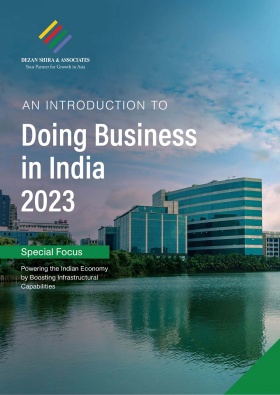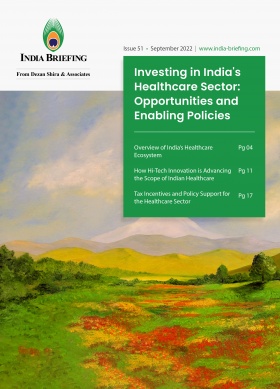India-Vietnam Trade: How West Bengal Plays a Key Role
India-Vietnam trade has experienced significant growth in recent years, with West Bengal playing a pivotal role in facilitating this bilateral trade relationship. Situated strategically, West Bengal serves as a gateway to Southeast Asian markets, including Vietnam.
West Bengal shares domestic borders with the Indian states of Jharkhand, Bihar, Odisha, Sikkim, and Assam, and international borders with Bangladesh, Bhutan, and Nepal.
Given its advantageous location, West Bengal holds immense importance in establishing connectivity between the two countries, which ultimately opens up abundant opportunities for long-term business collaboration between India and Vietnam. In this context, we discuss dynamics in the India-Vietnam trade partnership, focusing specifically on the West Bengal region.
Trade volume and growth
The bilateral trade between India and Vietnam has been on an upward trajectory in recent years. The trade volume between the two countries has expanded substantially, driven by various factors such as favorable trade policies, increased economic cooperation, and complementary trade sectors.
Notably, India has emerged as the eighth-largest economic partner for Vietnam, with bilateral trade turnover surpassing US$15 billion for the first time last year. While the trading value between the two countries has met the target, the bilateral trade turnover still falls short of its full potential and expectations. Currently, India constitutes approximately 2 percent of Vietnam’s total import and export turnover, while Vietnam represents about 1.5 percent of India’s total import and export turnover.
Key commodities
Trade between India and Vietnam encompasses a wide range of commodities. Some of the significant commodities traded are noted below:
- Agricultural products: India is a major supplier of a diverse range of agricultural products to Vietnam. Vietnam heavily relies on imported raw materials for its animal husbandry industry, and India serves as a significant source of animal feed and fodder. Additionally, aquaculture products feature prominently among the commodities imported by Vietnam from India. Other Indian agricultural exports to Vietnam include rice, maize, wheat, tea, spices, and fruits. The agroclimatic conditions in the east Indian state of West Bengal are highly conducive to agriculture, horticulture, and fisheries, making the region a substantial contributor to India’s top agricultural exports to Vietnam. Conversely, Vietnam exports agricultural products like coffee, pepper, cashew nuts, and other commodities to India.
- Iron and steel: India is a major producer of construction materials for Vietnam. It has access to an abundance of raw materials and refining and manufacturing facilities around the country. It is worth noting that West Bengal is famous for its mineral resources. The total exports of iron and steel from West Bengal were about US$1,851.38 million, accounting for 13.32 percent of the total exports of India.
- Machine, equipment, tools and instruments: With its flourishing manufacturing sector and a growing pool of skilled workers, India has emerged as one of the largest economies globally. The country boasts a diverse range of equipment and instruments that are highly sought after by countries looking to bolster their manufacturing capacities, including Vietnam. The state of West Bengal is expected to contribute to the export of mechanical products from India to Vietnam in the future.
Vietnam exports to India
As of 2022, Vietnam exports goods to India valued at US$7,961,827,560, encompassing a variety of commodities. Below is a list of the top 10 commodities that Vietnam exports to India.
|
Ranked |
Products |
Value (US$) |
|
1 |
Telephones, mobile phones and parts thereof |
1,522,199,493 |
|
2 |
Computers, electrical products, spare-parts, and components thereof |
1,034,542,669 |
|
3 |
Machine, equipment, tools and instruments |
804,243,018 |
|
4 |
Chemicals & Chemical products |
707,011,003 |
|
5 |
Other base metals and other base metal products |
671,674,766 |
|
6 |
Plastics & Plastic products |
310,818,969 |
|
7 |
Footwear |
223,354,320 |
|
8 |
Rubber & Rubber Products |
214,050,776 |
|
9 |
Textiles and garments |
158,418,127 |
|
10 |
Textile, leather and foot-wear materials and auxiliaries |
143,601,514 |
Source: General Department of Customs
West Bengal’s role in India-Vietnam trade
West Bengal, with its strategic location and well-developed infrastructure, plays a vital role in facilitating India-Vietnam trade. Speaking of economic size, West Bengal is ranked sixth in India on the basis of its gross state domestic product (GSDP), which was US$221.37 billion in 2022. Also that year, the total value of West Bengal exports was worth US$13.9 billion, up 55 percent from 2021.
The vast mineral riches and ideal agro-climatic conditions for fisheries, horticulture, and agriculture in West Bengal are the factors that fuel the state’s thriving economy. We explore some key factors below.
Land and sea connectivity
Travelling between the nations now takes only 2 hours compared to the earlier 8 to 10 hours at prices as cheap as only USD 200. – Vietnam’s Ambassador to India, Nguyen Thanh Hai
West Bengal is connected to Vietnam via land and sea routes. The Kolkata Port, situated in West Bengal, serves as a major maritime gateway for trade between the two countries. It provides efficient connectivity for cargo movement, including containerized goods. It also offers connectivity to rest of India through railways, roadways, ports, and airports, making it a valuable entry point for countries such as Vietnam.
In July 2022, Vietnam launched a direct shipping route linking the central region with Kolkata to facilitate trade and connectivity between the two countries. The shipping route is expected to open significant trading opportunities particularly with eastern India.
In 2019, India’s low-cost carrier Indigo launched direct flights between West Bengal’s Kolkata and Vietnam’s capital Hanoi and commercial center Ho Chi Minh City providing direct access to travelers of both countries. There are now 14 direct flights between Kolkata and Ho Chi Minh City.
A number of strategic corridors that aim to link India and Southeast Asia are also located in the state, notably the Kaladan Multi-Modal Transit Transport Corridor and the Chilahati-Haldibari Rail Link, in which West Bengal serves as a key connectivity hub.
Special Economic Zones (SEZs)
West Bengal has established SEZs, such as the Haldia Petrochemical SEZ and the Falta SEZ, which offer favorable policies, incentives, and infrastructure for promoting trade and investments. These SEZs attract Vietnamese companies looking to expand their presence in India.
Industrial capabilities
West Bengal boasts a diverse industrial base, including sectors such as textiles, chemicals, steel, and machinery. This industrial prowess allows West Bengal to cater to Vietnam’s import requirements and strengthens bilateral trade ties.
Tourism
There are several low-cost and direct flights operated between the two countries, including by India’s Indigo and Vietnam’s VietJet and Vietnam Airlines. Vietnamese tourists to India have increased, embarking on spiritual tourism and religious pilgrimages, among others. India is viewed as the ‘land of Buddha’ and has developed its Buddhist tourism landmarks.
However, the Indian market isn’t limited to religious tours and offers adventure tourism, health, and wellness tourism. Further, Indian tourists to Vietnam have increased significantly given the frequency of direct flights between the two counties.
Trade challenges and opportunities
While India-Vietnam trade has seen remarkable progress, several challenges and opportunities persist.
- Tariff barriers: Both countries impose tariffs on certain goods, limiting market access and hindering trade growth. Reducing or eliminating these tariffs through bilateral agreements could further boost trade between India and Vietnam. Vietnamese Ambassador to India Nguyen Thanh Hai has stated that a free trade agreement between both countries would be beneficial.
- Trade imbalance: The trade balance tends to favor Vietnam, with India importing more than it exports. Exploring avenues to enhance India’s exports, especially in sectors where West Bengal has a competitive advantage, can address this imbalance.
- Economic cooperation: Strengthening economic cooperation through initiatives, such as joint ventures, technology transfers, and knowledge sharing, can foster greater trade ties. This cooperation could focus on areas like agriculture, textiles, manufacturing, and technology.
- Logistics and infrastructure: Continual improvements in logistics, transportation networks, and port facilities in West Bengal will be crucial to facilitate seamless trade between India and Vietnam. Investments in infrastructure projects can reduce transit times and costs, promoting trade efficiency.
Act East Policy
The Act East policy of India serves as a crucial foreign policy initiative, focusing on enhancing India’s involvement with Southeast Asia and the broader Indo-Pacific region. It not only encompasses trade facilitation measures but also aims to strengthen overall engagement. Since its revision in 2014, the Act East policy has emerged as a prominent pillar of India’s foreign policy. Within the framework of this policy, India and Vietnam have established numerous areas of collaboration.
- Trade and investment: Bilateral trade between the two countries is growing steadily, and there are several Indian companies investing in Vietnam.
- Defense: India and Vietnam have held joint military exercises, and agreed to cooperate on defense procurement and technology.
- Energy: The two countries are working together to develop energy resources in the region. India is investing in oil and gas projects in Vietnam, and the two countries are also working together to develop renewable energy sources.
- Culture and education: India and Vietnam have a long history of cultural and educational ties. The two countries are working together to promote cultural exchanges, and there are a number of Indian students studying in Vietnam.
Summary
To summarize, the trade between India and Vietnam has experienced significant growth, prominently influenced by the West Bengal region. By capitalizing on West Bengal’s advantageous position, connectivity, and industrial potential, the trade partnership between the two countries can be further augmented. Overcoming market obstacles, including tariff and non-tariff barriers, and promoting Indian exports to Vietnam are vital steps to diversify trade and foster mutual economic growth.
About Us
India Briefing is produced by Dezan Shira & Associates. The firm assists foreign investors throughout Asia from offices across the world, including in Delhi and Mumbai. Readers may write to india@dezshira.com for more support on doing business in India.
We also maintain offices or have alliance partners assisting foreign investors in Indonesia, Singapore, Vietnam, Philippines, Malaysia, Thailand, Italy, Germany, and the United States, in addition to practices in Bangladesh and Russia.
- Previous Article India Increases Tax Exemption Limit on Leave Encashment for Private Sector Employees
- Next Article Amendments to IAS 12: Temporary Relief for Accounting Deferred Taxes under OECD Pillar Two Rules









